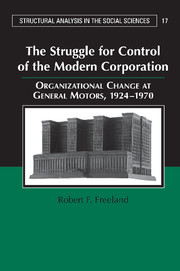 The Struggle for Control of the Modern Corporation
The Struggle for Control of the Modern Corporation Book contents
- Frontmatter
- Contents
- List of Figures and Tables
- Acknowledgments
- 1 The Modern Corporation and the Problem of Order
- 2 Creating Corporate Order: Conflicting Versions of Decentralization at GM, 1921–1933
- 3 Administrative Centralization of the M-form, 1934–1941
- 4 Participative Decentralization Redefined: Mobilizing for War Production, 1941–1945
- 5 The Split between Finance and Operations: Postwar Problems and Organization Structure, 1945–1948
- 6 Consent as an Organizational Weapon: Coalition Politics and the Destruction of Cooperation, 1948–1958
- 7 Consent Destroyed: The Decline and Fall of General Motors, 1958–1980
- 8 Conclusion
- Appendix: General Motors' Financial Performance, 1921–1987
- References
- Index
6 - Consent as an Organizational Weapon: Coalition Politics and the Destruction of Cooperation, 1948–1958
Published online by Cambridge University Press: 05 August 2011
- Frontmatter
- Contents
- List of Figures and Tables
- Acknowledgments
- 1 The Modern Corporation and the Problem of Order
- 2 Creating Corporate Order: Conflicting Versions of Decentralization at GM, 1921–1933
- 3 Administrative Centralization of the M-form, 1934–1941
- 4 Participative Decentralization Redefined: Mobilizing for War Production, 1941–1945
- 5 The Split between Finance and Operations: Postwar Problems and Organization Structure, 1945–1948
- 6 Consent as an Organizational Weapon: Coalition Politics and the Destruction of Cooperation, 1948–1958
- 7 Consent Destroyed: The Decline and Fall of General Motors, 1958–1980
- 8 Conclusion
- Appendix: General Motors' Financial Performance, 1921–1987
- References
- Index
Summary
The years from 1948 to 1955 were among the most profitable and successful in GM's history. Growing consumer income led to unprecedented demand for automobiles and enabled manufacturers to sell larger, more profitable cars. During much of this period, GM realized record breaking return on investment. Yet in 1958, following nearly a decade of unparalleled success, GM implemented yet another reorganization – one that marked the beginning of the corporation's long decline. In this chapter, I examine both the postwar years of success and the factors behind GM's reorganization and decline. During the postwar era, the split between finance and operations that emerged following the war led to increased factionalism and political struggle within the corporation. In this context, consent became a weapon in Detroit's battle against New York, solidifying political alliances between the president and the divisions, who took on general office staff and owners. The result was paradoxical. At the same time that GM entered the most profitable period in its history, it was also very much a corporation at war with itself. The reorganization of 1958 occurred as owners and general office executives attempted to reassert their control in response to Detroit. Although the reorganization put New York's finance staff in charge of the corporation, it did so at a price: the textbook M-form implemented in 1958 smashed the mechanisms for producing divisional consent, leading to resistance from below and eventual economic decline.
- Type
- Chapter
- Information
- The Struggle for Control of the Modern CorporationOrganizational Change at General Motors, 1924–1970, pp. 223 - 270Publisher: Cambridge University PressPrint publication year: 2000
